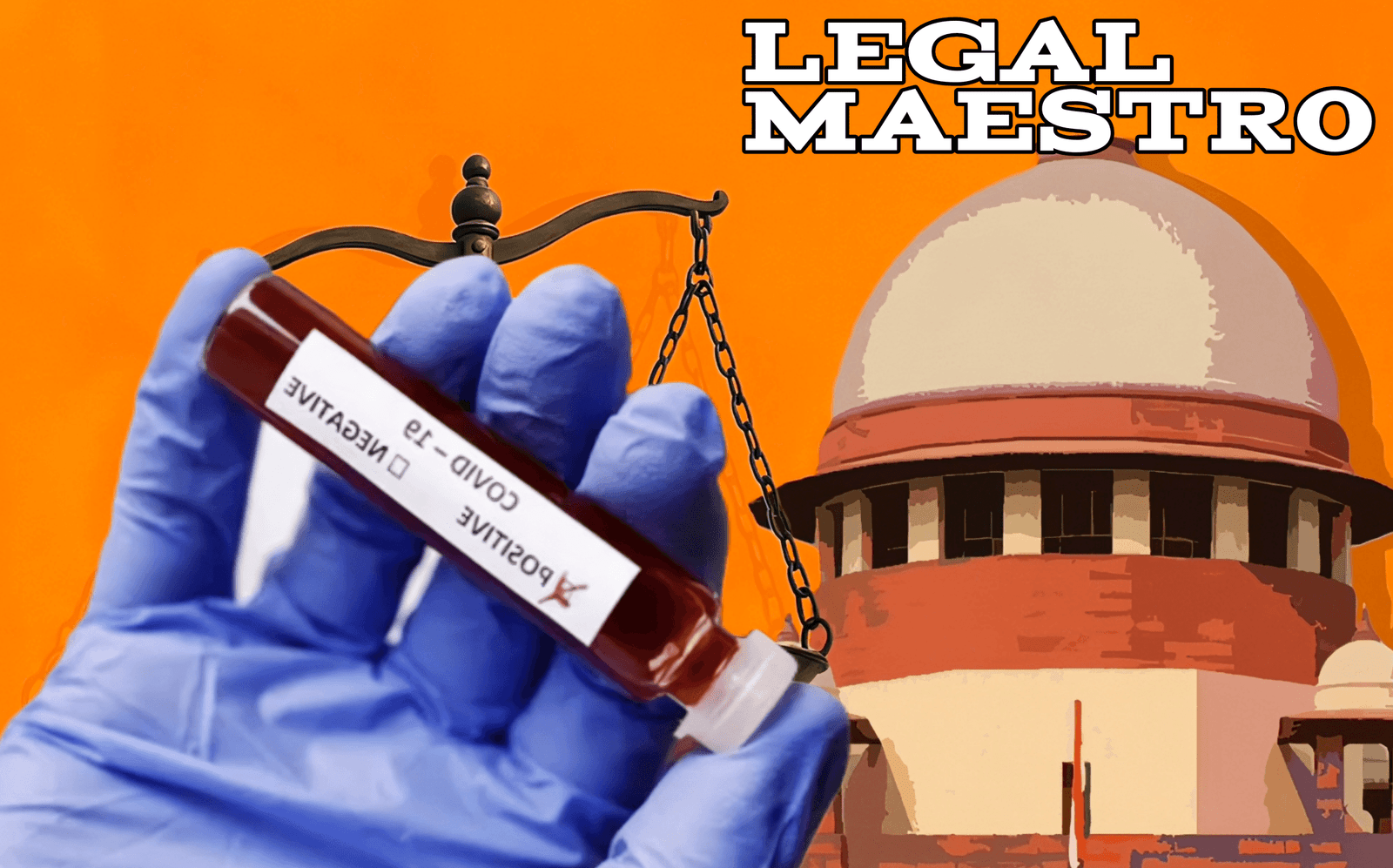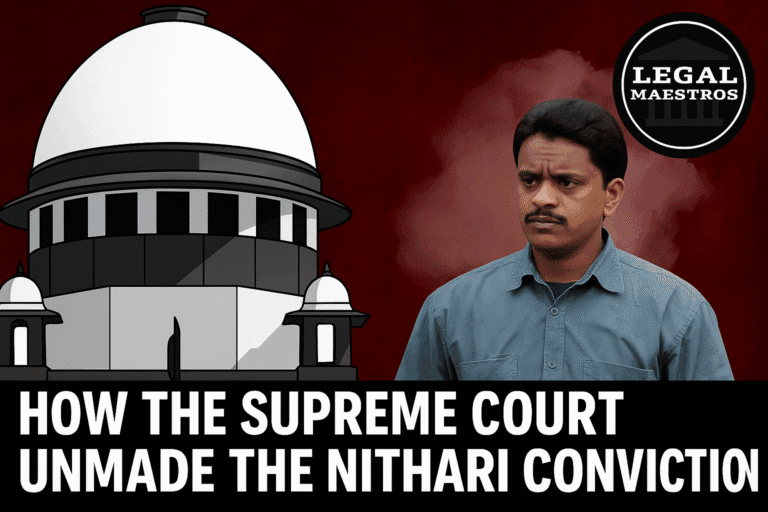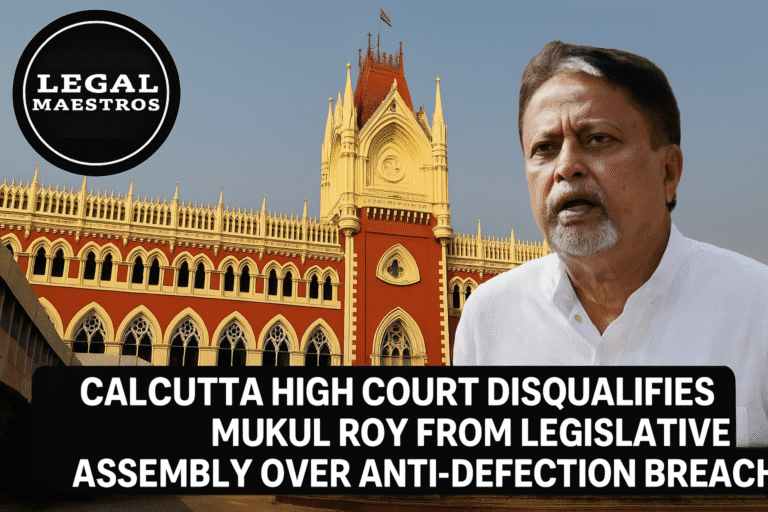
There has been a concerning increase in the number of COVID-19 cases in India, which can be attributed to the emergence of new variations and weakening of societal immunity.
The number of beds and oxygen available in hospitals is insufficient, testing capacities are being stretched to their limits, and vaccine coverage is still not uniform. Legal instruments, in addition to medical readiness, have a significant impact on the level of speed and efficiency with which the government can respond.
Both the Epidemic Diseases Act (ED Act) of 1897 and the Disaster Management Act (DM Act) of 2005 serve as the primary statutes that serve as the statutory foundation for containment and relief measures.
For any queries or to publish an article or post or advertisement on our platform, do call at +91 6377460764 or email us at contact@legalmaestros.com.
When applied to a contemporary pandemic, however, these laws reveal a number of inadequacies. An analysis of its advantages and disadvantages, as well as a case for specific reforms to strengthen India’s response to the pandemic, are presented in this article.
For More Updates & Regular Notes Join Our Whats App Group (https://chat.whatsapp.com/DkucckgAEJbCtXwXr2yIt0) and Telegram Group ( https://t.me/legalmaestroeducators )
Overview of India’s Epidemic Control Laws from a Historical Perspective
In the midst of the bubonic plague, the Emergency Department Act of 1897 was passed, which provided state governments with emergency powers to halt the spread of disease. Since it was so straightforward, it enabled quick action, yet it left many elements unclear.
For any queries or to publish an article or post or advertisement on our platform, do call at +91 6377460764 or email us at contact@legalmaestros.com.
Over a century later, in response to the tsunami that struck the Indian Ocean in 2004, the Disaster Management Act was enacted in order to simplify disaster response efforts under the umbrella of a single National Disaster Management Authority.
Both of these acts have been implemented during epidemics; however, neither of them was initially intended to be used during a prolonged pandemic that affected the entire nation and required interventions that were nuanced and multi-sectoral.
The Epidemic Diseases Act’s Most Important Provisions and the Limitations They Have To Offer
State governments “may take or require any person to take” steps that are judged necessary to contain an epidemic, as stated in Section 2 of the Emergency Department Act (ED Act). By using such broad terminology, a legal basis is established for the implementation of lockdowns, quarantines, and travel restrictions.
For any queries or to publish an article or post or advertisement on our platform, do call at +91 6377460764 or email us at contact@legalmaestros.com.
The Act, on the other hand, does not provide specific procedural protections or timetables, which results in different interpretations being given by different states. Section 3 can result in imprisonment or monetary fines for those who violate restrictions; nevertheless, the absence of specific criteria on offenses contributes to the inconsistent execution of these regulations.
Additionally, Section 4 provides minimal recourse for persons who have been adversely affected by overzealous actions, but it does protect government officers who are operating in “good faith.”
As far as the Act is concerned, there is no express necessity for transparency or public engagement when it comes to the formulation of regulations. As a consequence of this, citizens might not be informed of their rights or of the evidence that supports restrictive actions.
For any queries or to publish an article or post or advertisement on our platform, do call at +91 6377460764 or email us at contact@legalmaestros.com.
Principal Provisions of the Disaster Management Act and the Restrictions That Apply to Them
The DM Act bestows a great deal of authority upon both the central government and the state governments. In Section 6, the National Executive Committee, which is chaired by the National Disaster Management Authority, is given the authority to coordinate the actions of the corresponding response.
Under Section 10, the central government is granted the authority to offer legally obligatory directives to the states, which may include limits on mobility and the mobilization of resources. It is possible to declare a “local disaster” and activate state authorities at the state level according to Section 33, which provides for said declaration.
Because the DM Act is primarily concerned with natural disasters, epidemic-specific needs receive a limited amount of attention, despite the fact that these strengths exist. In addition to focusing on natural disasters such as earthquakes, floods, and cyclones, the Act also addresses infections without requiring individualized methods.
For any queries or to publish an article or post or advertisement on our platform, do call at +91 6377460764 or email us at contact@legalmaestros.com.
In addition, Section 51 stipulates penalties for obstruction of duty; nevertheless, these are frequently regarded as severe and are not applied to their full potential. disinformation that is disseminated through social media has a substantial impact on the behavior of the general public during a health crisis; nevertheless, Section 65, which addresses false warnings, is ineffectual in combating this disinformation.
Deficiencies in the Communication Between Governments
In the event of a pandemic, comprehensive cooperation between central, state, and local bodies is required. The ED Act, which is currently in effect, confers unilateral state powers, whereas the DM Act permits central directives but does not provide any methods for the resolution of disputes that are enforceable in the event that states disagree.
In the event that a state delays the imposition of containment zones while the center provides countrywide recommendations in accordance with Section 10, for instance, there is no legal mechanism that mandates compliance or arbitration under the circumstances.
For any queries or to publish an article or post or advertisement on our platform, do call at +91 6377460764 or email us at contact@legalmaestros.com.
As a result of this gap, swift and uniform containment measures are hampered, and persons are rendered confused regarding the restrictions that apply when crossing state boundaries.
Insisting on the Implementation of Explicit Procedures
Emergencies involving public health in the modern era necessitate striking a balance between individual rights and group safety. The ED Act and the DM Act do not contain any provisions that specify the procedures that must be followed in order to issue, review, or appeal emergency orders. It is possible for limitations to continue going on indefinitely because there are no deadlines for periodic reviews.
Before exercising broad powers, there is no requirement that the scientific justification be published or that expert advisory opinions be obtained. The public’s trust is damaged as a result of these omissions, which also pose constitutional problems regarding the right to life and liberty.
For any queries or to publish an article or post or advertisement on our platform, do call at +91 6377460764 or email us at contact@legalmaestros.com.
Initiatives for the Improvement of Existing Legal Provisions
For the purpose of filling the deficiencies that have been found, the following specific adjustments are proposed:
Clarify the Protocols that are Required by the ED Act
Modify Section 2 such that it mandates the publication of draft regulations, a statement of reasons, and a public comment window of forty-eight hours prior to the implementation of the regulations, unless there is an urgent urgency.
A new Section 2A should be introduced, which would require an expert committee consisting of public health and legal professionals to conduct a review of active regulations every six months.
For any queries or to publish an article or post or advertisement on our platform, do call at +91 6377460764 or email us at contact@legalmaestros.com.
Improve the Accountability of the Enforcement Process
In order to differentiate between minor and significant regulatory violations, Section 3 should be revised so that fines are in line with the level of damage that was caused.
To manage complaints about overreach, a new Section 4A should be added, which would establish a grievance redressal procedure at the district level. This mechanism should also include explicit timetables for resolution.
In accordance with the DM Act, Please Clarify Central-State Coordination
It is recommended that Section 10 be amended to include provisions for arbitration through a National Pandemic Council, as well as to identify the circumstances that need mandatory state compliance with central standards.
For any queries or to publish an article or post or advertisement on our platform, do call at +91 6377460764 or email us at contact@legalmaestros.com.
It is recommended that a new Section 10A be implemented, which will establish joint task forces in border districts for the purpose of coordinating containment efforts and sharing resources.
Adapt the Provisions to Prepare for Emergencies in Health
Biological disasters should be the subject of a new chapter in the catastrophe Management Act (DM Act), which should include a definition of the term “biological disaster” as well as specific methods for testing, contact tracing, vaccine distribution, and the management of misinformation.
Establishing explicit criteria for the continuity of necessary services, such as food, medications, and utilities, during lockdowns should be included under Section 35. There should also be sanctions for arbitrary denial of these services.
For any queries or to publish an article or post or advertisement on our platform, do call at +91 6377460764 or email us at contact@legalmaestros.com.
Take measures to safeguard civil liberties and improve transparency.
Make changes to Section 73 of the ED Act such that it requires authorities to document measures taken in “good faith,” with the possibility of judicial review after a period of ninety days.
The DM Act should be amended to include a new section 12 that requires the posting of data dashboards on case numbers, healthcare capabilities, and vaccine coverage. These dashboards should be updated on a daily basis at both the states and the national level.
Studying the Most Successful Methods Used Around the World
South Korea and New Zealand are two examples of countries that have enacted pandemic law that includes well defined communication routes, stages of response, and built-in accountability. features such as statutory timetables for lifting measures and independent review panels are among the features that India has the ability to modify. A reduction in ad hoc decision-making and an increase in public confidence will result from the incorporation of these practices into domestic law.
For any queries or to publish an article or post or advertisement on our platform, do call at +91 6377460764 or email us at contact@legalmaestros.com.
Getting Ready for the Upcoming Waves
Not only does a strong legislative framework solve the current jump in the number of cases, but it also helps India get ready for potential future health problems. Statutes that have been amended ought to incorporate provisions for faster clinical trials, authorizations for therapies to be used in an emergency, and supply chain safeguards for essential medical goods. During times of emergency, the government ensures that access is both predictable and equitable by enshrining these provisions in law rather than depending on presidential directives.
Regarding the Development of a Legal Architecture That Is Resilient
The growing number of COVID-19 cases in India highlights the urgent requirement to update our laws and regulations on the control of epidemics. The Equal Employment Opportunity Act of 1897 and the Disability Discrimination Act of 2005 have been helpful, although they are lacking in terms of procedural clarity, intergovernmental collaboration, and protection of rights.
India is able to construct a flexible legal architecture by implementing certain reforms, which include the definition of protocols, the enhancement of accountability, and the establishment of transparent review procedures. The implementation of such measures will not only improve the effective management of the current crisis, but it will also boost readiness for future pandemics, thereby striking a balance between the constitutional liberties and the public health imperatives.
For any queries or to publish an article or post or advertisement on our platform, do call at +91 6377460764 or email us at contact@legalmaestros.com.




![Research Assistantship @ Sahibnoor Singh Sindhu, [Remote; Stipend of Rs. 7.5k; Dec 2025 & Jan 2026]: Apply by Nov 14, 2025!](https://legalmaestros.com/wp-content/uploads/2025/11/Gemini_Generated_Image_s0k4u6s0k4u6s0k4-768x707.png)
![Karanjawala & Co Hiring Freshers for Legal Counsel [Immediate Joining; Full Time Position in Delhi]: Apply Now!](https://legalmaestros.com/wp-content/uploads/2025/11/Gemini_Generated_Image_52f8mg52f8mg52f8-768x711.png)